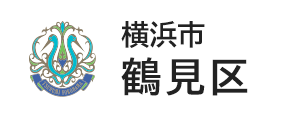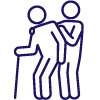- Yokohama-shi Top Page
- Tsurumi Ward Top Page
- Disaster Prevention and anti-crime program
- Disaster Prevention and Disasters
- evacuation sites
- Welfare refuge (Special evacuation sites)
The text is from here.
Welfare refuge (Special evacuation sites)
Last updated on December 9, 2024.
For those who have difficulty evacuating at evacuation shelter or at home in the event of a large-scale disaster, Yokohama has concluded agreements with social welfare facilities in the city and positioned it as a special evacuation sites.
From April 2018, the name will be changed to "welfare shelter" widely used throughout the country.
1 What is the Welfare refuge (Special evacuation sites)?
If a large-scale disaster causes enormous damage and becomes unable to live at home, you will have to live an evacuation life in evacuation shelter, such as elementary and junior high schools.
The Welfare refuge is a secondary refuge to accommodate those who find it difficult to live in evacuation shelteradvocate, such as the elderly, disabled childrenevacuation shelter, pregnant women, infants andadvocate.
2 Evacuation to Welfare refuge
Those who have difficulty maintaining their lives at evacuation shelter or at home and need special care.
Professionals (public health nurses) check the situation of the individual and whether they are certified as requiring nursing care, and determine the necessity of evacuation to the welfare refuge.
- Welfare refuge fulfills the necessary functions and roles, so those who are not considered eligible cannot evacuate.
- Welfare refuge is not always established immediately after a disaster.
- In principle, travel from evacuation shelter must be done by the person or family.
3 Target facilities
It applies to social welfare facilities that have concluded an agreement with the ward office. (Elderly facilities, facilities for the disabled, community care plazas, etc.)
4 Q&A
Q: What kind of facility is a welfare shelter? What kind of equipment and support do you have?
A: It is social welfare facilities such as facilities for the elderly, facilities for the disabled, and community care plazas that have concluded agreements with the ward office.
We can provide assistance to the extent possible, depending on the conditions of the facilities, in an environment where advocate needs to live easily, such as barrier-free facilities.
Even in the welfare refuge, you will have to work with the surrounding refugee to live an evacuation life while helping each other.
Q: When will welfare refuge be opened? Who can evacuate?
A: Welfare refuge is not always established immediately after a disaster.
The ward office requests the establishment sequentially from facilities that have been confirmed and have been prepared for operation.
In order to make effective use of limited resources, it is necessary to identify the situation in advocate after the disaster and evacuate from those with higher priority.
Q: What are the criteria for accepting welfare refuge? Who decides how and how?
A: Since the facilities that serve as welfare refuge are limited, it is difficult to accept all eligible advocate at once.
Professionals (public health nurses) judge those who have evacuated to evacuation shelter (or from information on advocate collected in evacuation shelter) who need more support.
Based on the judgment of professionals, etc., the ward office decides who to accept at which welfare evacuation center.
5 Agreement facilities
| Facility type | Name | Location |
|---|---|---|
| Community Care Plaza | Shiota Community Care Plaza, Yokohama City | 4-171-23, Honchodori, Tsurumi-ku |
| Yamukai Community Care Plaza, Yokohama City | 4-32-11, Yakou, Tsurumi-ku | |
| Terao Community Care Plaza, Yokohama City | 6-37-14, Higashiterao, Tsurumi-ku | |
| Higashi Terao Community Care Plaza, Yokohama City | 1-12-3, Higashiterao, Tsurumi-ku | |
| Komaoka Community Care Plaza, Yokohama City | 4-28-5, Komaoka, Tsurumi-ku | |
| Yokohama City Tsurumi Market Community Care Plaza (Yuzuru) | 11-5, Ichibashimocho, Tsurumi-ku | |
| Tsurumi Central Community Care Plaza, Yokohama City | 1-23-26, Tsurumichuo, Tsurumi-ku | |
| Yokohama City Barley Community Care Plaza | 4-6-4, Namamugi, Tsurumi-ku | |
| Yokohama City Baba Community Care Plaza | 7-11-23, Baba, Tsurumi-ku | |
| Special elderly nursing homes ※1 | Shin-Tsurumi Home | 2-42, Egasakicho, Tsurumi-ku |
| Yamayuri Home | 2-15-18, Shishigaya, Tsurumi-ku | |
| Shoju no Sato Tsurumi | 2-1, Egasakicho, Tsurumi-ku | |
| Wakatake Tsurumi | 1-4-20, Yakou, Tsurumi-ku | |
| New Bird Shishigaya | 3-10-8, Shishigaya, Tsurumi-ku | |
| Shoju no Sato Ono | Tsurumi Ward 4-145-18 Shimonoya | |
| Home for Persons with Disabilities | Home of Local Activities Home Contact | 4-5-37, Namamugi, Tsurumi-ku |
| Local Activities Home Motomiya | 2-4-78, Motomiya, Tsurumi-ku | |
| Tsurumi Local Activities Home Trunk | 4-21-20, Kitaterao, Tsurumi-ku | |
| Elderly Welfare Center | Tsurujuso | 4-39-1, Baba, Tsurumi-ku |
| Training facilities for the elderly | Freyu | 1-15-2, Suehirocho, Tsurumi-ku |
| Nursing care facilities for the elderly | Ushioda Elderly Health | 1-6-20, Yakou, Tsurumi-ku |
| Support facilities for persons with disabilities | Hope | 1-14-18, Yakou, Tsurumi-ku |
| Mental Handicapped Life Support Center | Tsurumi Ward Life Support Center | 28-4, Toyookacho, Tsurumi-ku |
※1 In the event of a large-scale disaster, those who have been certified as requiring long-term care by The Long-term Care Insurance, who have difficulty living at evacuation shelter or at home and need assistance from facility staff may be accepted by emergency admission at nursing homes.
6 Related Links
Regional Disaster Countermeasures - advocate Support Guide for Disasters (Health and Social Welfare Bureau Health and Welfare Division page)
Inquiries to this page
Tsurumi Ward General Affairs Department General Affairs Division
Phone: 045-510-1656
Phone: 045-510-1656
Fax: 045-510-1889
E-Mail address [email protected]
Page ID: 762-458-961













